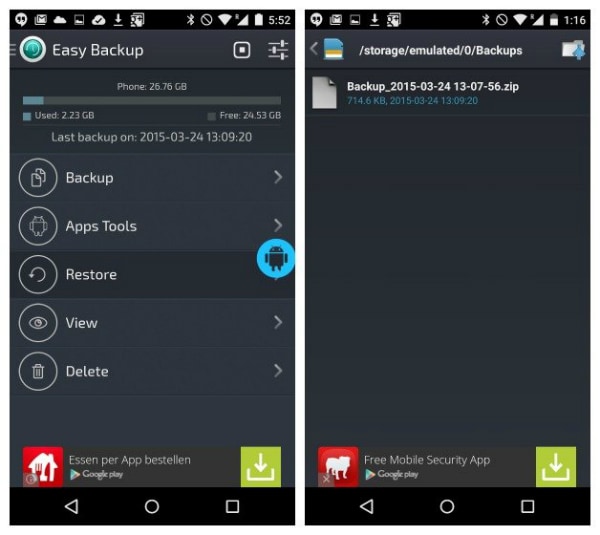

- Ultimate backup to a new phone full#
- Ultimate backup to a new phone Pc#
- Ultimate backup to a new phone Offline#
- Ultimate backup to a new phone free#
Ultimate backup to a new phone Pc#
This also means that sync options are mostly non-existent, although some do let you register mobile devices on top of your PC allowance.īack in the olden days, sharing lots of files meant waiting a long time for email attachments to load, carrying a USB (or two) from A to B, or just giving up on technology altogether and printing a copy to take or (gasp) post to your friend or colleague.
Ultimate backup to a new phone full#
In addition to this, most full backup providers also only let you backup from a single device, or charge extra if you want to store files from more than one. Instead of worrying about file sharing options, then, they simply give you a safe place to keep a spare copy of your files. It’s a little lonelyĪs a rule, online backup services are not very big on file sharing, mainly because it can have a knock-on effect on security, making it harder to keep your data away from prying eyes. Fortunately some providers such as Backblaze take steps to avoid this by limiting their software’s CPU usage while, with others, scheduling the program to run for limited periods at convenient times does a great job of limiting the impact. Once that’s done, you might still encounter a few speed issues as scanning for new or updated files can slow down your computer. This speeds up the process considerably, as there are no speed or bandwidth caps in sight, although you will have to pay for the privilege. Having said that, some providers do offer express uploads, which let you ship your files directly to the company on an external hard drive. Unfortunately, running full backup processes can be a slow process, with the initial backups of large numbers of files sometimes taking weeks or even months to complete. The not-so-good: You might be in for a wait
Ultimate backup to a new phone free#
On the downside, you’ll struggle to find any free versions of online backup software, but most providers offer free trials so that you can at least get a taste of what you’re signing up for. They also work out cheaper per GB of space than most online storage providers, starting from around $50 per year, with the majority accepting monthly payments. Using an online backup service is a great way to keep your files secure, as they typically boast some of the best security features around. Keep files secure without breaking the bank They’re also great if you want a low-maintenance program that doesn’t require regular input, as backups and updates usually run automatically – no need for you to do any more than set them up and let them run, although we’d also recommend regularly checking your logs to make sure that everything’s running smoothly. Most of them offer unlimited storage space, and have no restrictions on the type or size of files you can backup. Generally speaking, online backups are the best option if you’re looking to store large amounts of data. The good: Store lots of data with minimal effort For our next trick, read on to find out everything you need to know when you’re choosing an online service.
Ultimate backup to a new phone Offline#
So there it is - online and offline backups, explained. While each approach has its own strengths and weaknesses, combining them will give your data the best possible chance of a long and happy life. Between them, then, these three data storage methods should give your files a fighting chance of surviving whatever gets thrown at them.
Although expensive and more technologically demanding than the other options, NAS also typically gives you the option to use data redundancy measures - effectively keeping backups of your backups. It’s also a great way to store files from multiple devices, and is considerably speedier than saving things in the Cloud. There’s also the ever-present risk of hard drive failure, which afflicts almost all storage options - and that’s where NAS comes in. Unfortunately, however, they’re also much more vulnerable to physical damage - terabytes of data can be lost in moments if there’s a fire, flood, or even if your device just takes a nasty fall. Physical storage devices (both NAS and external hard drives) avoid lots of those issues by being entirely in your own hands - removing the element of chance that comes of handing over your data to a online backup provider. There’s also the risk that your chosen company will go out of business, or simply that you won’t be able to get online (or have the time required to retrieve all of your files) at a crucial moment. While files that you save to the Cloud are usually subject to stringent safety measures in providers’ datacenters and have lots of advantages including easy remote access and automatic updates, it’s impossible to keep a close eye on exactly how your files are being treated. This is because, sadly, no form of backup is infallible. 3-2-1 Backup, and is recommended for everyone looking to backup their data - whether it’s a few personal files, or a company’s worth of data.


 0 kommentar(er)
0 kommentar(er)
